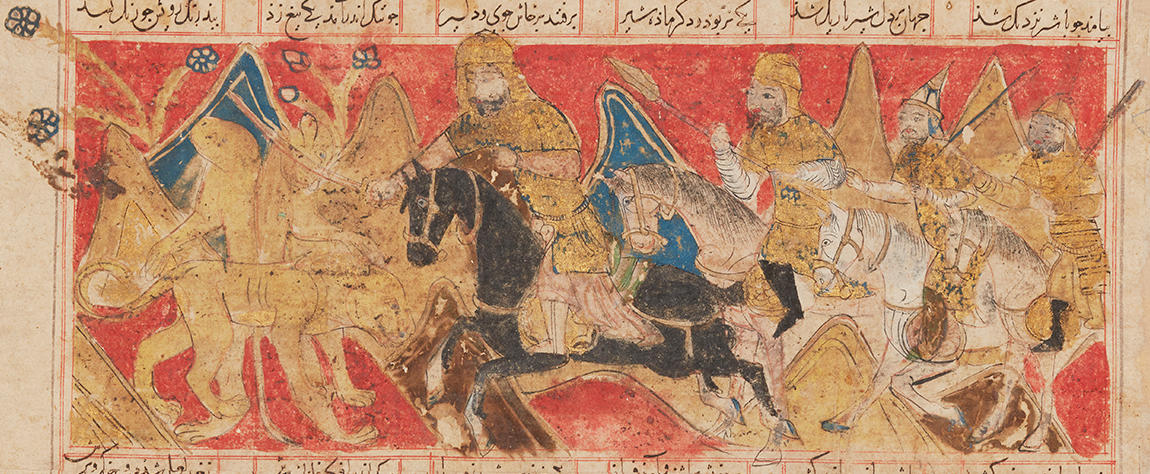
Try Amazon Fresh
Ilkhanid Illustration
Isfandiyar's second labour: he fights the lions
from the 1341 Inju Shahnama, Shiraz



ISFANDIYAR’S SECOND EXPLOIT: HE KILLS TWO LIONS
FOLIO FROM A DISPERSED COPY OF FIRDAUSI’S SHAHNAMEH (BOOK OF KINGS)
Accession Number: AKM34
Place: Iran, Shiraz
Dimensions: 35.3 x 28 cm
Date: 741 AH / 1341
Materials and Technique: Ink, coloured pigments and gold on paper
Recounting the story of Iran from mythical times through to the arrival of the Muslim Arabs in the mid-7th century AD, the epic poem the Shahnameh (Book of Kings) was originally completed in 1010 by the poet Firdausi. These dramatic scenes centering on Isfandiyar, son of King Gushtasp, were included in a 1341 Shahnameh that is now dispersed. The story of Isfandiyar’s exploits recalls the seven trials that the great hero Rustam underwent in his quest to liberate King Kay Kavus from captivity in a much earlier Shahnameh story (see AKM30). Isfandiyar endured his labours en route to rescuing his two sisters, who were captured during the ongoing war between Iran and Turan. Isfandiyar decided to take the shortest but most dangerous route to the Brazen Hold, the Turanian fortress made of brass where his sisters were imprisoned.
Further Reading
After slaying a pair of enormous wolves (an exploit not illustrated in the 1341 Shahnameh), Isfandiyar confronted two lions. According to Firdausi’s poem, Isfandiyar smote the lion with his sword, and then immediately killed the lioness in the same fashion. However, AKM34 depicts three lions rather than two, including one who appears to be facing forward while standing on its hind legs. Isfandiyar is depicted at the centre of the composition clad in gold armour and riding a black horse. Following closely behind is his trusted companion Bishutan, plus two additional warriors who are not mentioned in the poetic text. Interestingly, the Shahnameh verses recounting this story indicate that the lion fight took place on a plain, whereas the painting depicts a more dramatic backdrop: a mountainous landscape with blue and gold peaks and large flowering plants.
The illustration of Isfandiyar’s third exploit (AKM35) in which Isfandiyar battles a dragon — depicts an enormous dragon, coiled and crouched against a dark mountain at the left side of the composition. Clearly, the creature has already swallowed the two horses and wooden box-like carriage bristling with swords that Isfandiyar had used to charge it: its gaping mouth contains part of the box as well as the hindquarters and tail of one of Isfandiyar’s horses. Its enormous body now looks black but may originally have been silver, while its many coils are highlighted with swaths of blue paint and gold rosettes. Standing against the painting’s ochre background, Isfandiyar hacks at the dragon’s head with his sword while his mounted troops, including a flag bearer, look on in dismay and astonishment.
Crowded and bursting from their horizontal frames, these illustrations were originally located on the back and front of the same folio (folio 180) in the 1341 Shahnameh. They exist today, however, as two separate leaves with sheets of plain paper on their backsides. When this manuscript of Firdausi’s Shahnameh was brought from Iran and dispersed in the early 20th century, several illustrated folios were split in half.
— Marianna Shreve Simpson
Source: Aga Khan Museum AKM34
Geneva, Aga Khan Trust for Culture
Title of Work: Shahnama (1341)
Manuscript: 2005.1.28-37 (Ir.M. 6-6/I)
Accession Number: 2005.1.34 (Ir.M. 6/F)
Chapter Gushtasp (120 years)
Scene: Isfandiyar's second labour: he fights the lions
Dimensions (h x w): 91 x 232 mm
Format: Stepped within borders
Reconstructed Folio: 180r
Hijri Date: 741 Dhu'l-Qa'da 20
Gregorian Date: 1341 May 14
School: Inju'id Shiraz
Source: Shahnama Project